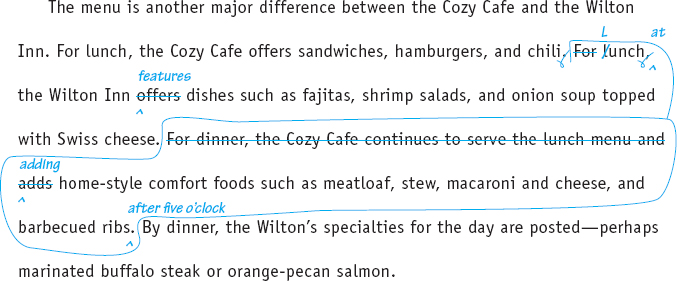Revising and Editing
For more on revising and editing strategies, see Ch. 23.
Focus on Your Thesis. Reconsider your purpose when you review your draft. If your purpose is to illuminate two subjects impartially, ask whether you have given readers a balanced view. Obviously it would be unfair to set forth all the advantages of Oklahoma City and all the disadvantages of Honolulu and then conclude that Oklahoma City is superior on every count.
Of course, if you love Oklahoma City and can’t stand Honolulu, or vice versa, go ahead: don’t be balanced; take a stand. Even so, you will want to include the same points about each city and to admit, in all honesty, that Oklahoma City has its faults. One useful way to check for balance or thoroughness is to outline your draft and give the outline a critical look.
If classmates have made suggestions, perhaps about clearer wording to sharpen distinctions, use their ideas as you rework your thesis.
| WORKING THESIS | Although students learn a lot in both of the required introductory biology courses, one class teaches information and the other teaches how to be a good learner. |
| REVISED THESIS | Although students learn the basics of biology in both of the required introductory courses, one class teaches how to memorize information and the other teaches an invaluable lesson: how to be an active learner. |
Vary Your Wording. Make sure, as you go over your draft, that you have escaped a monotonous drone: A does this, B does that; A has these advantages, B has those. Comparison and contrast needn’t result in a paper as symmetrical as a pair of sneakers. Revising and editing give you a chance to add lively details, transitions, dashes of color, and especially variety:

REVISION CHECKLIST
- Does your introduction present your topic and main point clearly? Is it interesting enough to make a reader want to read the whole essay?
- Is your reason for doing all the comparing and contrasting unmistakably clear? What do you want to demonstrate, argue for, or find out? Do you need to reexamine your goal?
- Have you used the same categories for each item so that you treat them fairly? In discussing each feature, do you always look at the same thing?
- Have you selected points of comparison and supporting details that will intrigue, enlighten, and persuade your audience?
- What have you concluded about the two? Do you prefer one to the other? If so, is this preference (and your rationale for it) clear?
- Does your draft look thin at any point for lack of evidence? If so, how might you develop your ideas?
- Have you used the best arrangement, given your subjects and your point?
- Are there any spots where you need to revise a boringly mechanical, monotonous style (“On one hand, … now on the other hand”)?
See more editing and proofreading strategies.
After you have revised your comparison-and-contrast essay, edit and proofread it. Carefully check the grammar, word choice, punctuation, and mechanics — and then correct any problems you may find.
EDITING CHECKLIST
Find the relevant checklist sections in the Quick Editing Guide for more help. See also to the Quick Format Guide.
| Have you used the correct comparative forms (for two things) and superlative forms (for three or more) for adjectives and adverbs? | A7 | ||
| Is your sentence structure correct? Have you avoided writing fragments, comma splices, or fused sentences? | A1, A2 | ||
| Have you used parallel structure in your comparisons and contrasts? Are your sentences as balanced as your ideas? | B2 | ||
| Have you used commas correctly after introductory phrases and other transitions? | C1 |